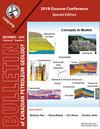加拿大阿尔伯塔盆地中南部泥盆系碳酸盐岩富锂油田卤水演化
Q3 Earth and Planetary Sciences
引用次数: 2
摘要
关于加拿大阿尔伯塔盆地内卤水的起源和特征,有一个漫长而广泛的研究历史。本文研究了阿尔伯塔盆地西南部晚泥盆世天鹅山组、Nisku组和Leduc组富锂(bbb50 mg/kg)盐水的来源。现有资料表明,阿尔伯塔盆地西南部晚泥盆世碳酸盐岩中存在两种富锂盐水,它们的地球化学特征明显不同,因而具有不同的演化历史。天鹅山组富锂卤水是由前寒武纪结晶基底排出的富锂流体与岩盐溶蚀混合而成。天鹅山盐水与大气水的混合程度尚不清楚。Nisku组和Leduc组富锂盐水的形成可以解释为可能来自中泥盆世草原蒸发岩组的富锂晚期蒸发岩矿物优先溶解到蒸发富集的晚泥盆世海水中。浓稠的富锂卤水向下运移到下伏的早泥盆世温尼佩戈什组,然后向西运移,响应于侏罗纪开始的西倾运动。在Laramide构造作用下产生的水力梯度作用下,富锂盐水与注入阿尔伯塔盆地西南部泥盆纪的大气水混合后被稀释。本文章由计算机程序翻译,如有差异,请以英文原文为准。
Evolution of Li-enriched oilfield brines in Devonian carbonates of the south-central Alberta Basin, Canada
There is a long and extensive history of study regarding the origins and characteristics of brines within the Alberta Basin of Canada. This study focuses on the origins of Li-enriched (>50 mg/kg) brines of the late Devonian Swan Hills, Nisku and Leduc Formations of the southwestern Alberta Basin. Available data show that two Li-enriched brines having distinctly different geochemical characteristics, and thus distinct evolutionary histories, exist within the late Devonian carbonates of the southwestern Alberta Basin.
Li-enriched brine of the Swan Hills Formation appears to have been formed by dissolution of halite and mixing with Li-enriched fluids expelled from Precambrian crystalline basement. The degree of mixing between Swan Hills brines and meteoric water is unknown.
Formation of Li-enriched brines in the Nisku and Leduc Formations could be explained by preferential dissolution of Li-enriched late-stage evaporite minerals, likely from the middle Devonian Prairie Evaporite Formation, into evapoconcentrated late Devonian seawater. Dense Li-enriched brine migrated downward into the underlying early Devonian Winnipegosis Formation and then westward in response to westward tilting beginning in Jurassic time. Li-enriched brine was then diluted by mixing with meteoric water driven into the Devonian of the southwestern Alberta Basin in response to hydraulic gradients created by the effects of Laramide tectonics.
求助全文
通过发布文献求助,成功后即可免费获取论文全文。
去求助
来源期刊

Bullentin of Canadian Petroleum Geology
Earth and Planetary Sciences-Geochemistry and Petrology
CiteScore
2.50
自引率
0.00%
发文量
0
期刊介绍:
The Bulletin of Canadian Petroleum Geology is a peer-reviewed scientific journal published four times a year. Founded in 1953, the BCPG aims to be the journal of record for papers dealing with all aspects of petroleum geology, broadly conceived, with a particularly (though not exclusively) Canadian focus. International submissions are encouraged, especially where a connection can be made to Canadian examples.
 求助内容:
求助内容: 应助结果提醒方式:
应助结果提醒方式:


